Searching for the Andean Mountain Cat, November 2018
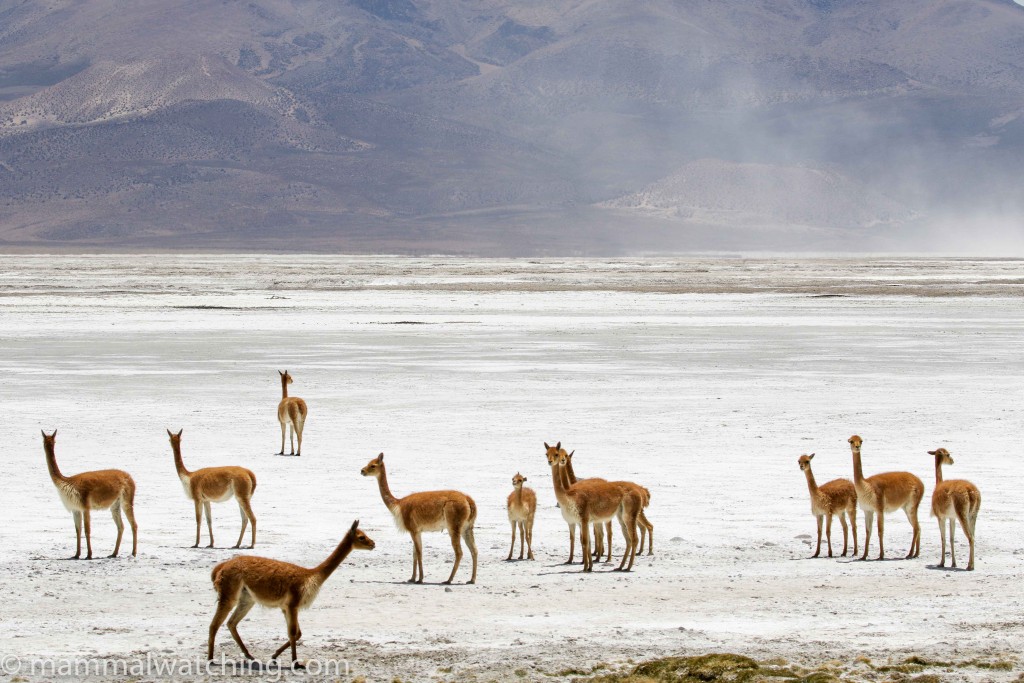
Vicuna, Vicugna vicunga. Salar de Surire
Although I place myself only half way up the Webb-Telfer scale of cat fanaticism, the Andean Mountain Cat has been on my Top 21 List of Species to See for as long as I can remember. Very few mammalwatchers have seen this Latino Snow Leopard and for many years I would get excited if I heard someone had even seen tracks. Actually spotting the animal seemed pretty much impossible. And right now it must be among the five hardest cats to see wild.
So when Phil Telfer asked if I was interested in a trip to northern Chile to go looking for them the conversation went something like:
“Hi Jon, are you interested in going to look for Andean Mounta…” “YES!”
I imagine John Wright – the other member of our group – took about as much persuading. So in November 2018 we were flying to Arica – in the very far north of Chile – to meet Enrique Couve, from Chile’s Far South Expeditions, who was on a mission to find us a Mountain Cat.
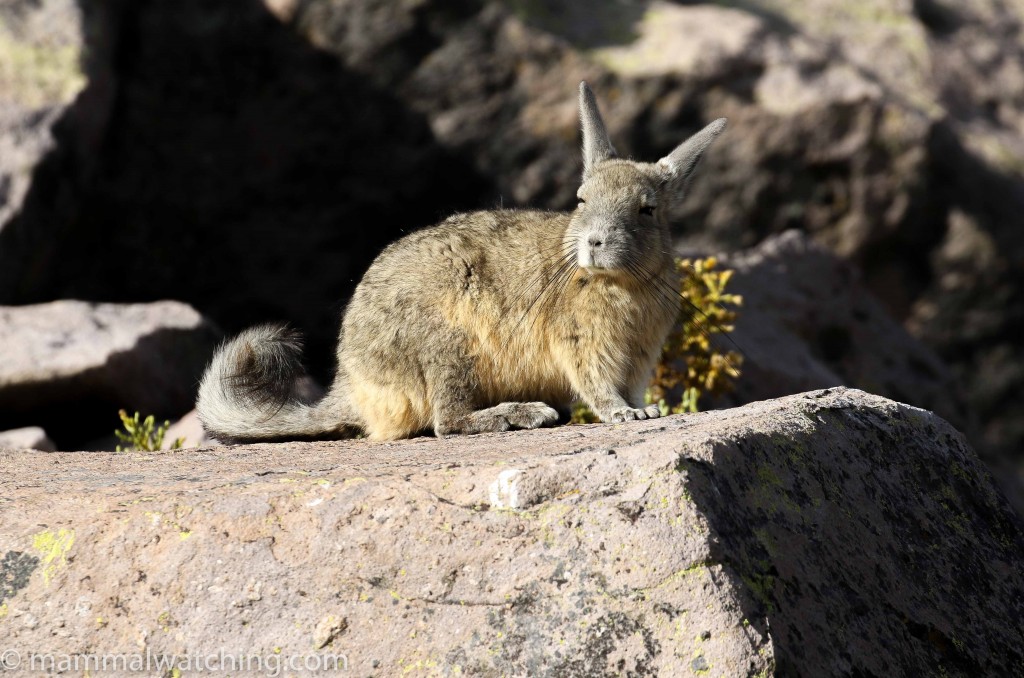
Southern Mountain Viscacha, Lagidium viscacia
Logistics
Phil had been talking with Enrique about this trip for years. And Enrique, who would like to start running Mountain Cats tours to the area, had been putting in a good deal of time and research. He’d made several trips to the area this year to scout locations and had seen Mountain Cats each time so he felt ready to take us along.
Enrique organised our accommodation, hired a 4WD (not strictly necessary for the roads we drove on but definitely helpful) and carried an extra 140 litres of diesel to take with us. Fuel is hard to find on the altiplano.
Enrique is a bit of a legend. He seems never to get tired and on several occasions WE asked HIM if WE could rest! He’s extremely knowledgeable about all of Chile’s wildlife and a very nice guy.
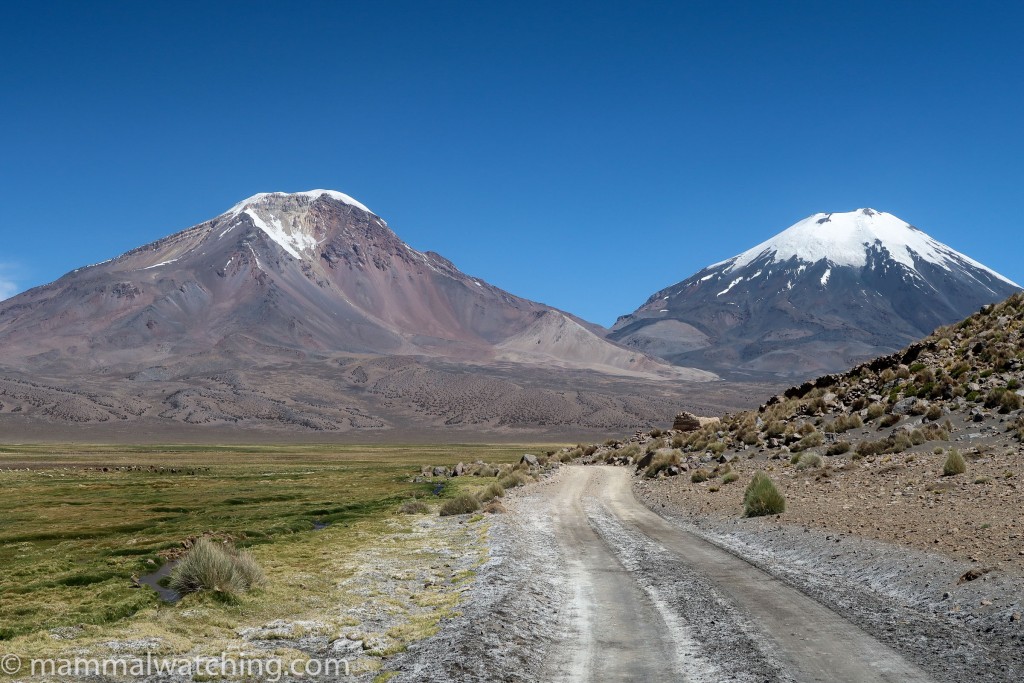
Lauca National Park
I am not going to give super detailed information for some of the cat sites as the information belongs to Enrique. He put in all the effort in nailing these locations down, so it is not for me to share it. I would though recommend using a guide if you go in search of the cat even if you have all the details. It can be a logistical challenge to travel around the altiplano and – more importantly – I imagine it would be extremely hard to find a Mountain Cat on your own. You need every extra sets of eyes you can muster when searching for this animal.
Weather
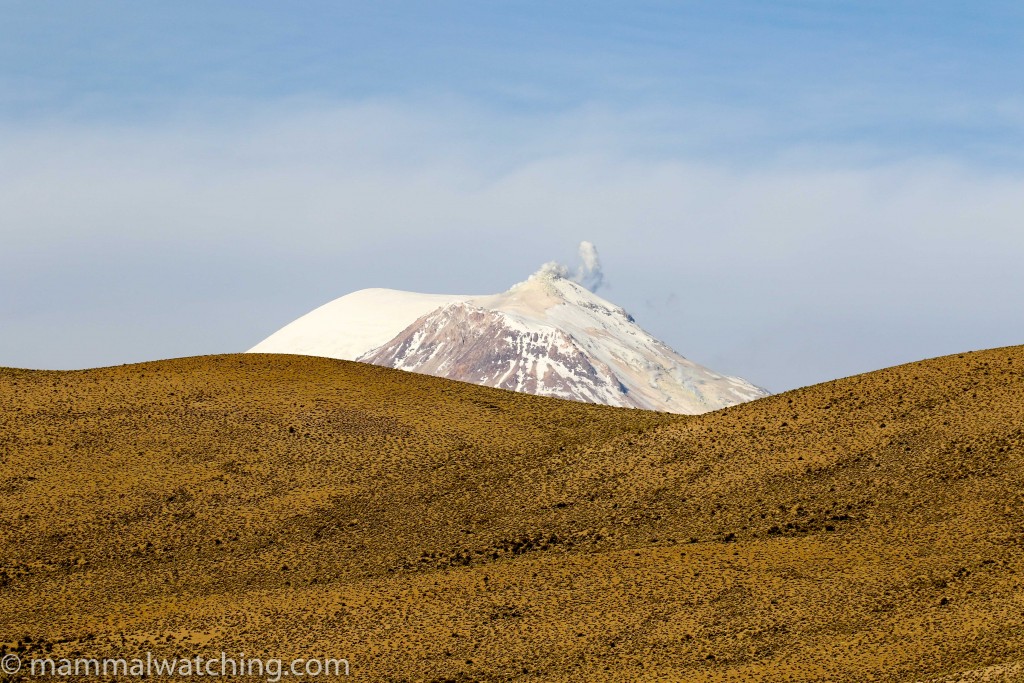
Late November is early summer in northern Chile. We got several seasons of weather each day and it was usually too cold, too hot or too windy. It was often pleasant between 0930-1030 and 1630-1730. We were up at around 4000 metres so temperatures plummet as soon as the sun sets: spotlighting trips are very cold and I didn’t have a lot of luck with my thermal scope at night. In part this might have been because of the very steep temperature gradient between the freezing air and the sun-baked rocks: everything was glowing. In part it might be because mammals seem very well insulated up there and give off very little heat: though the faces of the Vicuna would glow in the scope, their bodies barely registered in the scope.
Early mornings were bitterly cold. It took me several hours for my fingers and toes to recover after one pre-dawn stake out in the car.
By mid-morning it is hot and at 4000 metres the sun is intense so pack more sunscreen than I did. By early afternoon it was often windy and very dusty and this lasted until close to sunset most days. I understood from Enrique that the afternoon winds pick up as you move into summer.
Itinerary
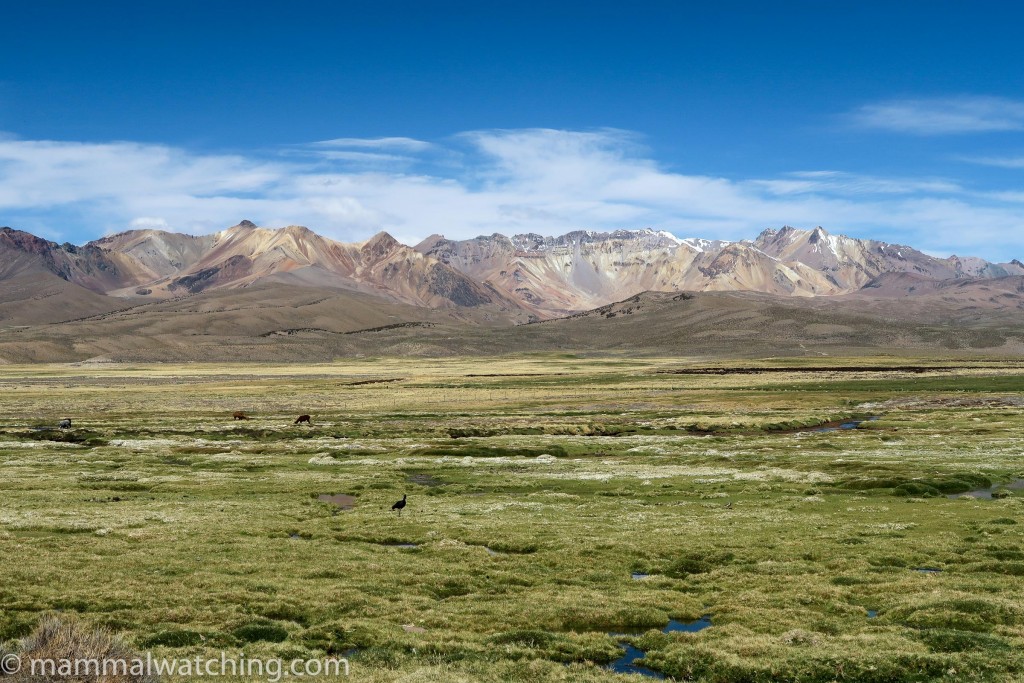
17 November – Meet in Arica and drive 3 hours to Putre (3500 m ASL).
18 November – Exploring Lauca NP for Mountain Cats and more. Overnight in Putre.
19 – 22 November – Staying at Lauca Cruzani homestay (4000m ASL) looking for Mountain Cats.
23 – 24 November – Staying in Arica and looking for Marine Otters and Burmeister’s Porpoises.
Where and How to Look for Mountain Cats
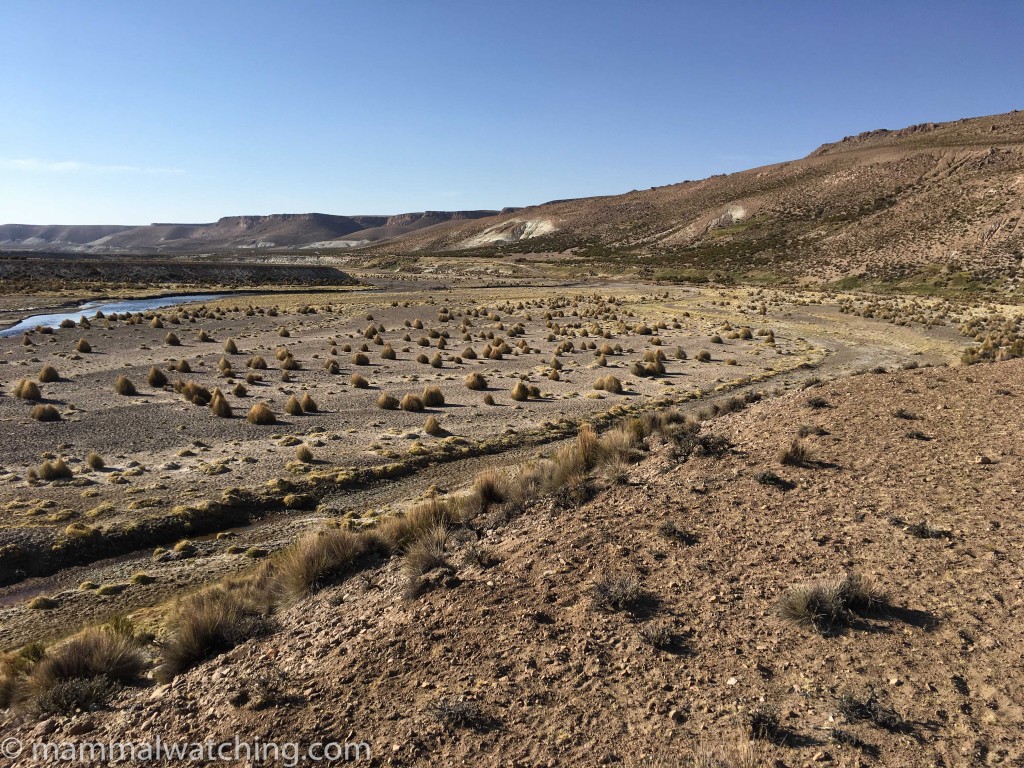
Andean Mountain Cat habitat
After hearing about Enrique’s success on recent trips I was feeling pretty optimistic about our chances. Until I saw the altiplano. There is a huge amount of territory to search around Lauca National Park. And there are very few cats. Worse, unlike Snow Leopards, it seems unlikely you will spot a cat strolling along a ridge line. Most of Enrique’s recent sightings were of animals in grassland: to say there is plenty of cover for a cat to hide in is an understatement. This was a handful of needles in a thousand haystacks.
But Enrique knows a great deal about Chile’s wildlife and has seen Mountain Cats several times, including two animals just a month before we visited. So we figured if we were going to see one it would be with him. He had been focusing his recent searching during daylight: not because he thought the animals were necessarily easier to see then, but because he prefered to see them well and wanted to take photos. But more on this later.
Enrique has seen cats in the middle of the day several times and feels that Northern Viscacha colonies are not – as you might imagine – always the best places to look. he thinks the cats may prefer tola grass habitat (in the picture above) that is close to water. This habitat is also popular with tinamous and tuco-tucos, both of which are a popular Mountain Cats meal. In recent visits to Lauca he had seen cats near the town of Putre, around the Salar de Surire salt lakes and close to the village of Parinacota. But Enrique thought we should focus our efforts around the abandoned settlement of Misitune (which auspiciously means “Place of the Cat”) because he had seen two animals near here in October 2018.
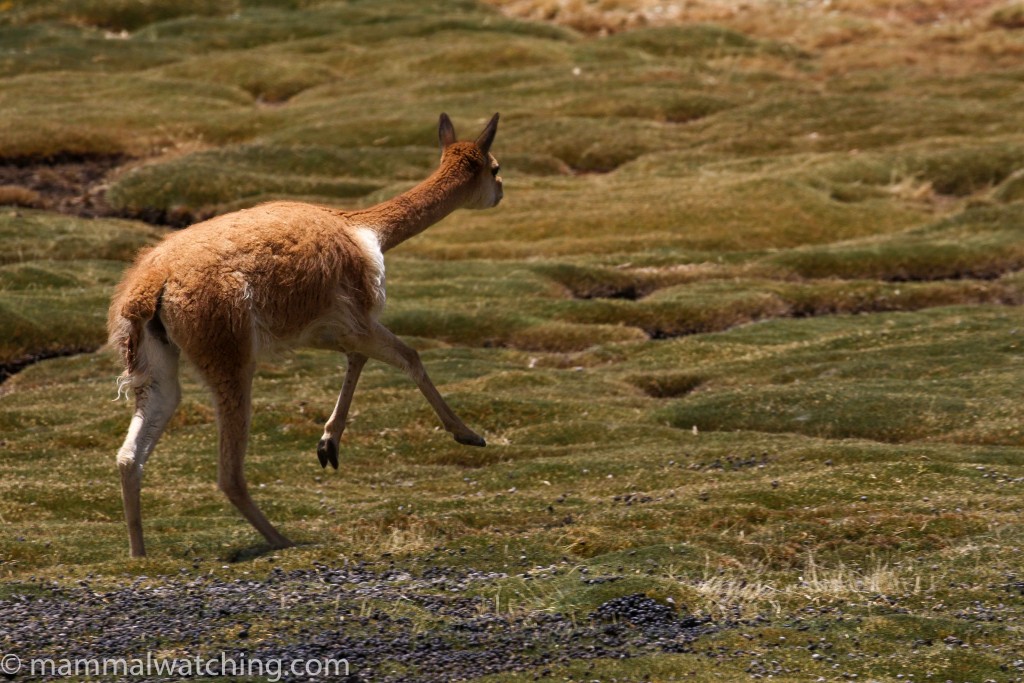
Vicuna, Vicugna vicugna
And so we spent a good deal of time staking out one particular site along the river where he had seen cats in October. And a good deal more time driving slowly along nearby roads hoping to get lucky, as well as looking for tracks and other signs. We also spotlit for three nights which I suspect is probably the easiest way to find the cats. Not necessarily because they are more active then, but because their eyeshine is a lot easier to see than the animal itself.
Site Guide
Putre
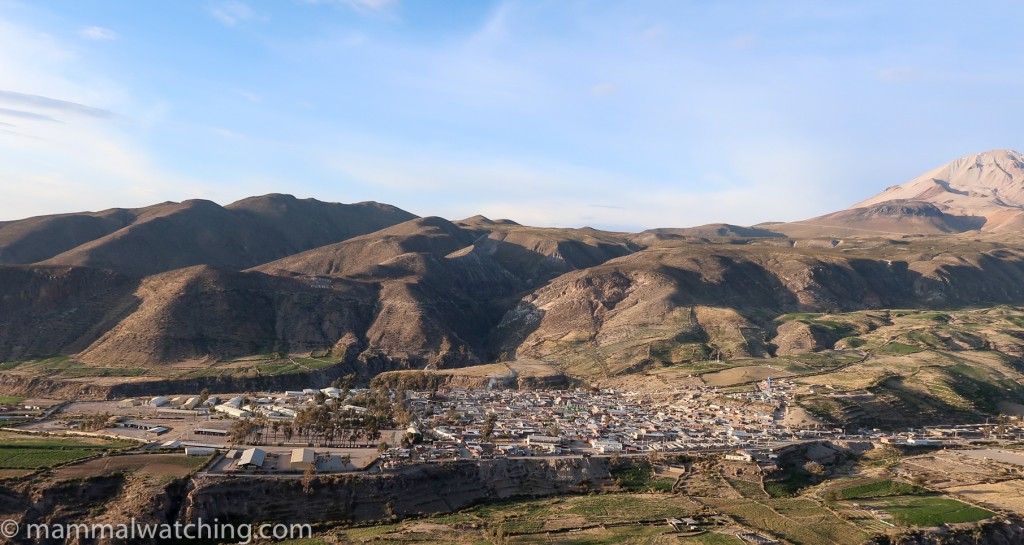
We stayed at the comfortable Hotel Qantati, in the small town of Putre for two nights to acclimatise to the altitude. Enrique has seen a cat close to the town once but it makes more sense to search for them higher up in the mountains.
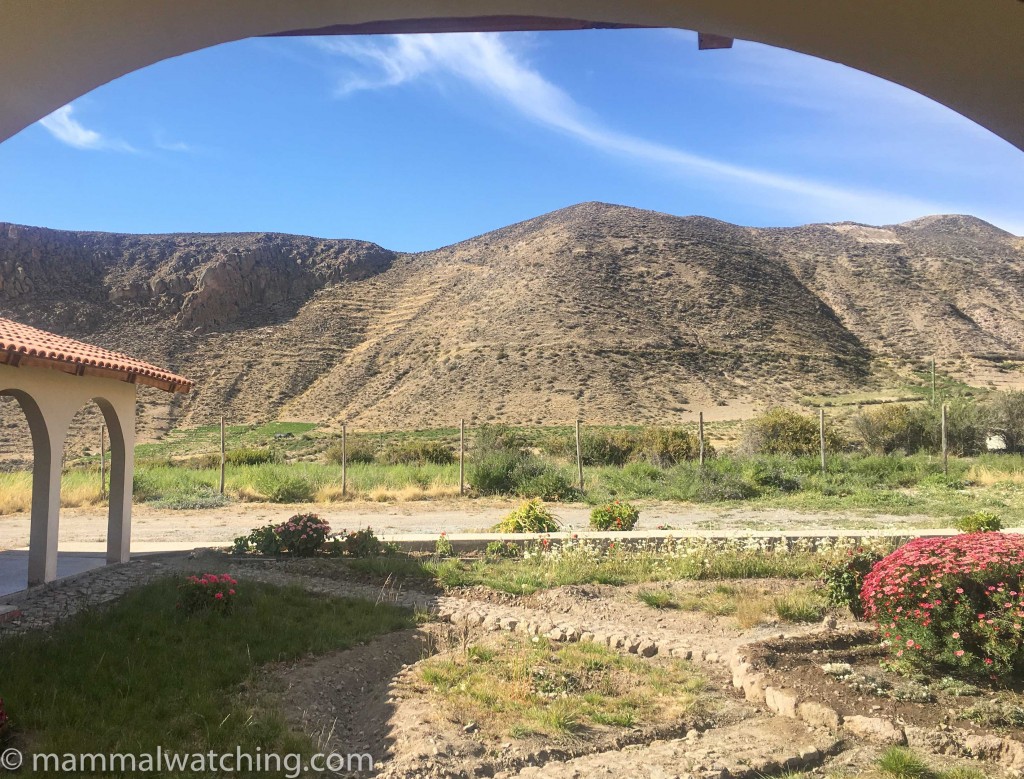
Hotel Qantati
The most important species at Putre are the Taruka (or North Andean Huemuls). A herd of 20 or so animals live in the hills around town and seem to be left alone by the locals. Each evening they descend to graze near Putre and return to the hills again in the mornings. They seem nearly always to be around but we didn’t see them until our last morning at Putre (by which point we had become stressed about seeing them). It seems like the hills to the north east of town are the best area to search which is where we saw them. Try driving along the A189 back up to the main road an hour or two after sunrise.
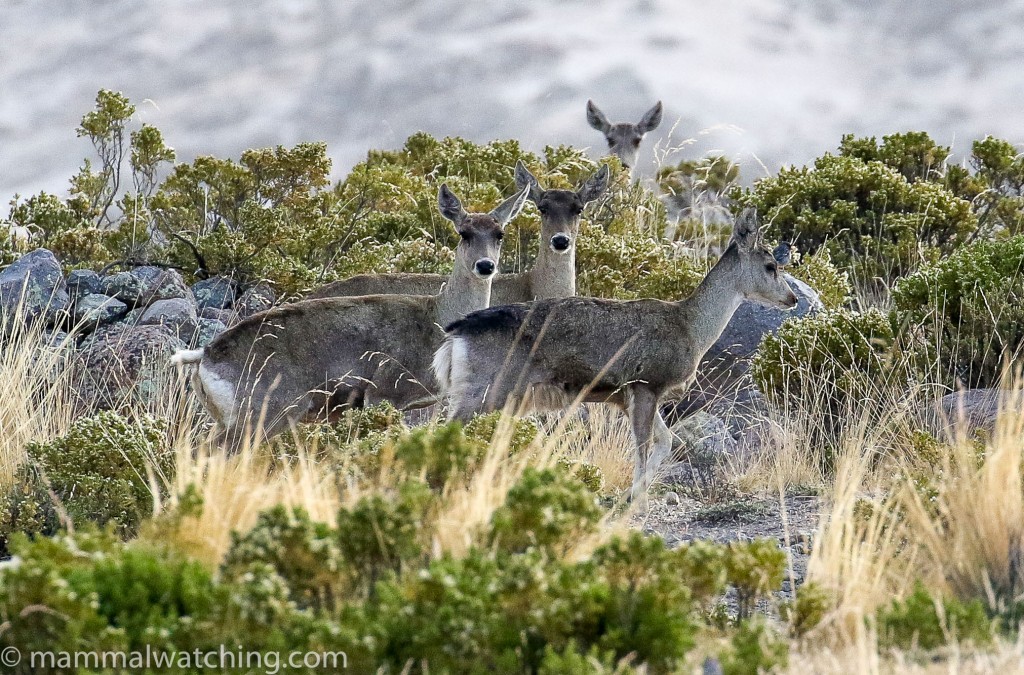
Taruca (North Andean Huemul), Hippocamelus antisensis
I set some small mammal traps in rocky vegetation behind the hotel and caught several small mice, all of which were one of the Abrothrix (grass mice) species. From what I can gather Andean Grass Mouse (Abrothrix andinus) rather than the almost identical looking Olivaceous Grass Mouse is the species up this high but I am ready to be corrected.
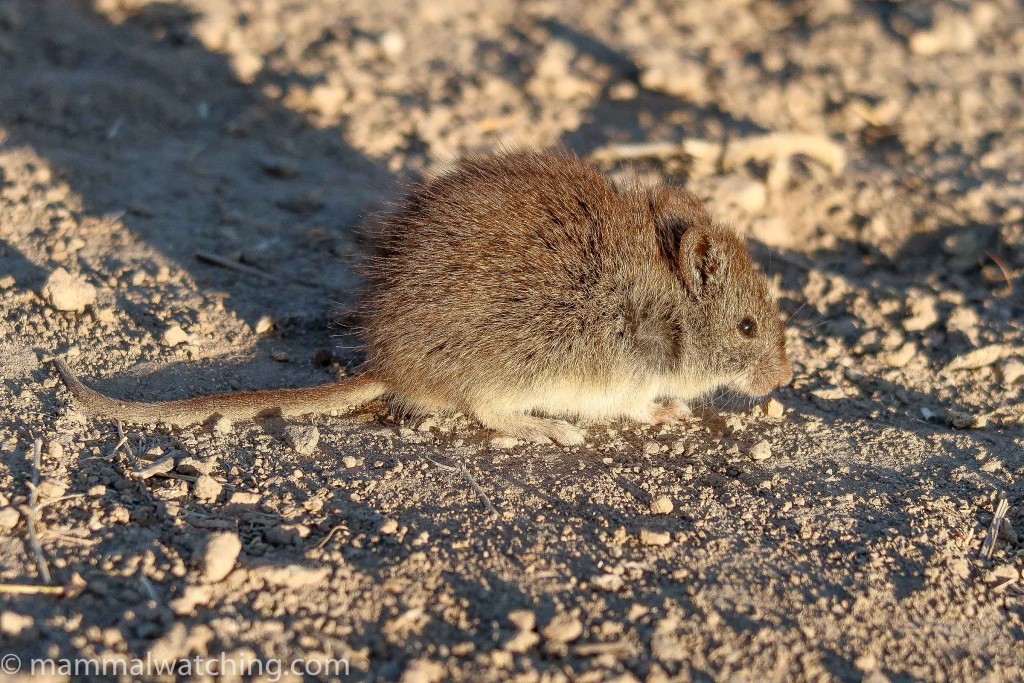
Andean Grass Mouse, Abrothrix andinus
Just outside Putre – along the road back to Arica – you pass a small lookout (mirador) parking area overlooking the town. Women sell trinkets here. They also feed the local mice which we were reliably informed are usually scampering around people’s feet in the mornings. We stopped here in the early afternoon and again towards sunset but were too late to see the mice: an Akodont species by the looks of the photos we were shown. I’d suggest stopping in between 9-11 a.m. if you want to see them. And if you do please let me see your pictures.
Las Cuevas
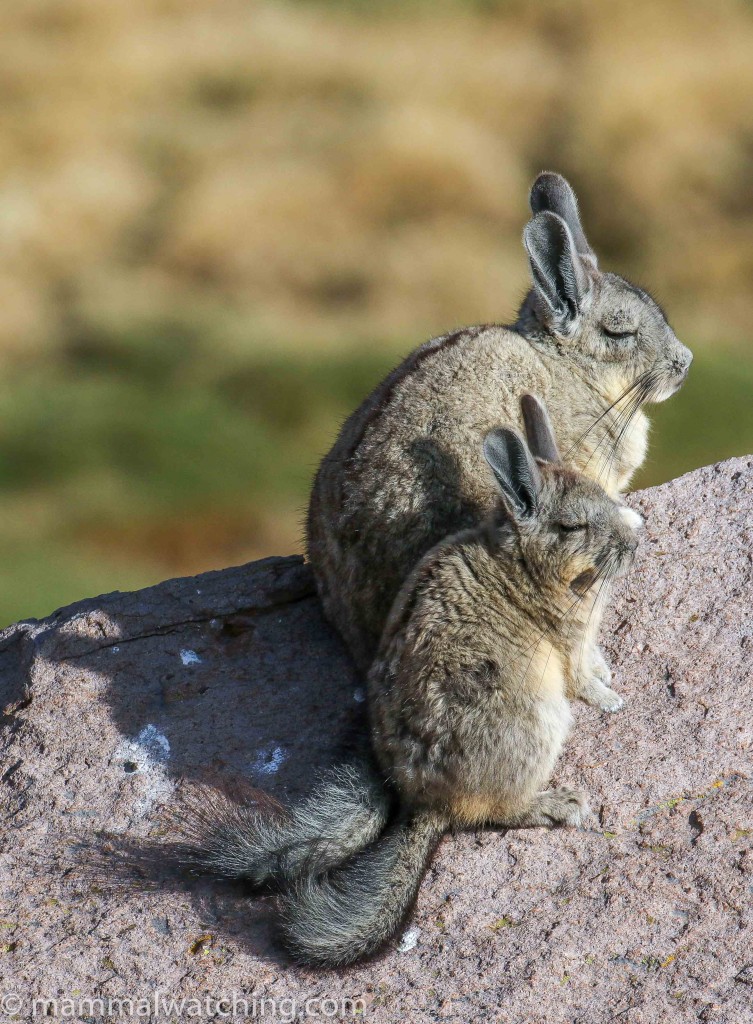
Southern Mountain Viscacha, Lagidium viscacia
Guarderia Las Cuevas is a stopping point/ranger station soon after you cross into Lauca National Park from Putre. There is a short trail on both sides of the road.
The trail from the parking area runs parallel to the road. There are many Southern Mountain Viscachas here (formerly these were Northern Viscachas but the species have been lumped) and Enrique said you can usually see a large-eared species of mouse here, foraging at the edge of the meadow next to the trail (usually running in and out of the boulders below the road). We stopped here three times but didn’t see the mice. I am not sure what the species is: it seems that Darwin’s Mouse, once thought to be widespread in Lauca, is not in fact found in the park and is replaced by other species this far north.
The trail continues on the other side of the road and runs past a couple of small caves. No mice here either but plenty of tame viscachas and we also saw a Culpeo sitting on the rocks above us. Enrique once found a small bat in the toilets here: he didn’t know which species.
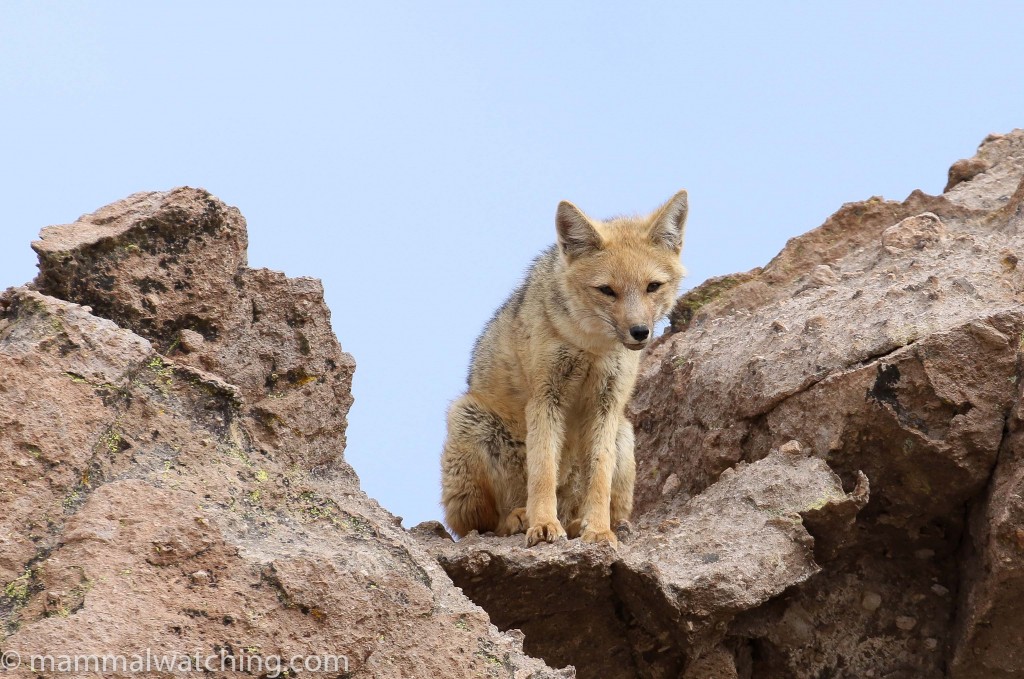
Culpeo, Lycalopex culpaeus
Parinacota
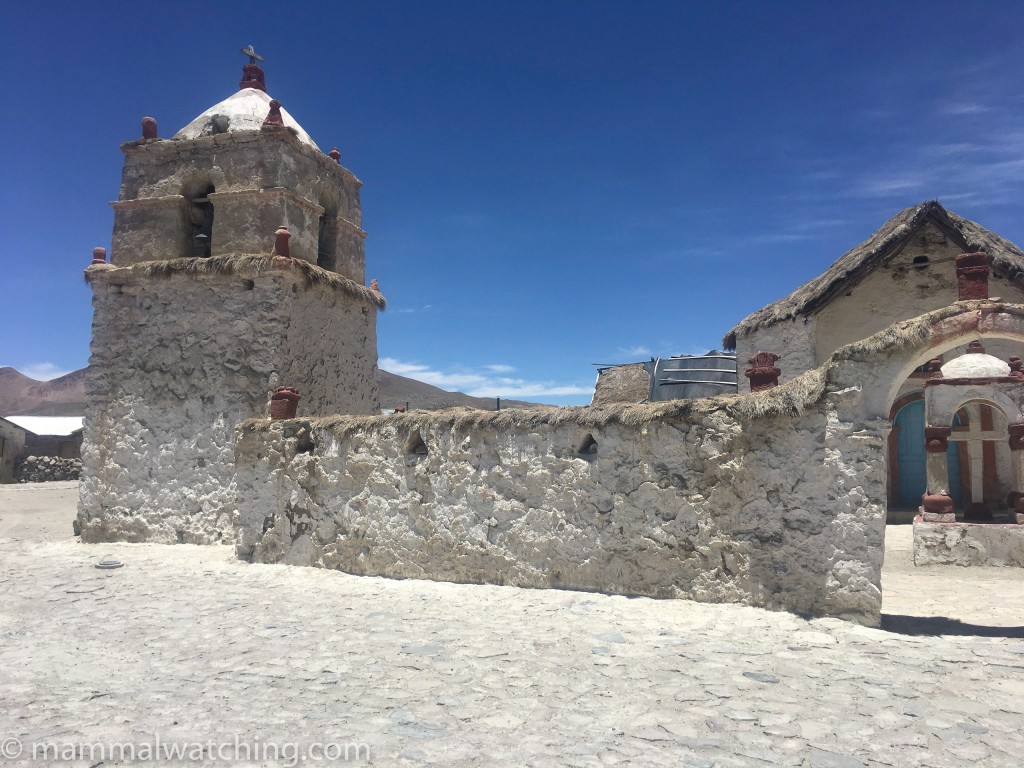
The tiny – and all but abandoned – village of Parinacota looks like a set from a spaghetti western. The lady who ran the souvenir stall there told me there were rats all over the rocks around town. But we couldn’t find any during an hour’s search in the mid-afternoon.
Driving north out of the village on the A93 you should see many tuco-tuco mounds. We stopped near here at a fresh mound and opened the tunnel with a stick. We sat in the car and waited for fifteen minutes. Nothing. I checked the burrow and the crafty little tuco-tuco had sneakily resealed the entrance while remaining hidden from us (in part due to some nonstrategic parking on our part I must confess).
Ten minutes up the road we spotted dirt flying and saw a tuco-tuco above the ground briefly. All the tuco-tucos in this region ought to be Highland Tuco-tuco (Ctenomys opimus) according to the literature. Yet the animals here did look quite different to those we saw (and photographed) close to Misitune, which were more silvery than the light brown animals here, and with a more distinct eye stripe. For the time being I have recorded them all as Highland Tuco-tucos but perhaps one day another species will be described from here…. You can never have too many Tuco-tuco species. Well maybe you can: the IUCN already list almost 60 species.
We also stopped somewhere near here to inspect multiple rodent burrows: Enrique said it they belonged to a Soco colony (Octodontomys gliroides) and he’d once seen an animal above ground here in the late afternoon. Perhaps we were too early or perhaps he was simply lucky to see this species which I think is primarily nocturnal.
Salar de Surire
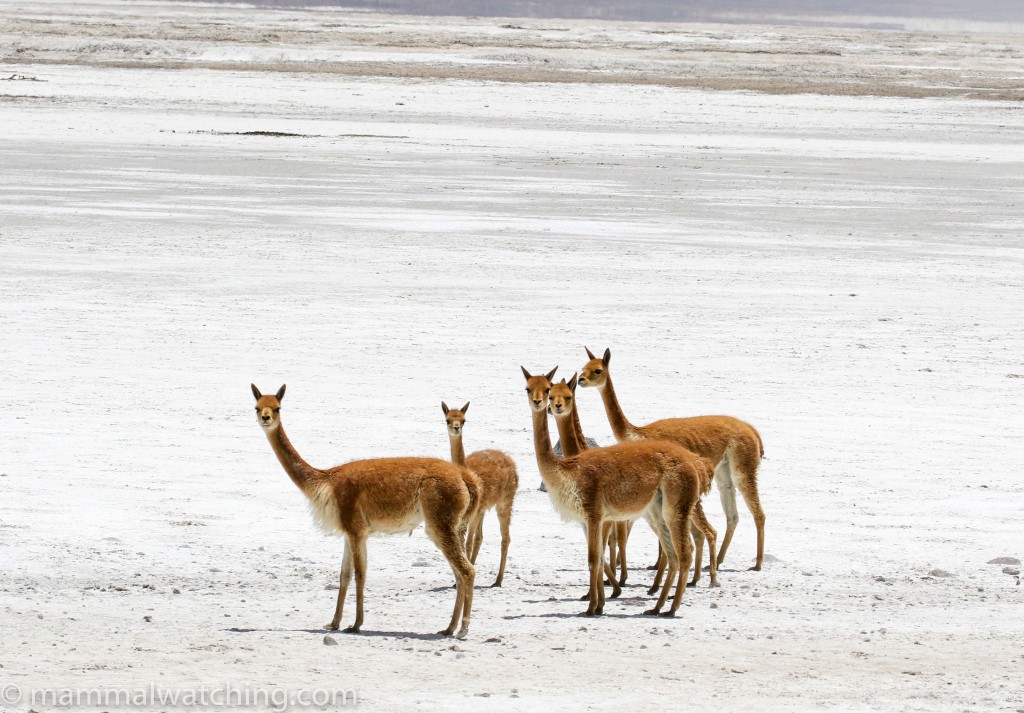
Vicuna, Vicugna vicuna
We spent the best part of a day driving to – and then around – the famous Salar de Surire salt flats. The area is rumoured to be good for Andean Mountain Cats, but Enrique had not seen animals here often. Cats have been seen occasionally around the ranger station, where Viscachas are abundant and tame, but not recently so far as we could tell. We walked up the hill behind the ranger’s house and couldn’t see any sign of cats.
Cats or not, it is a beautiful spot and the salt flats are home to three flamingo species.
Lake Chungará
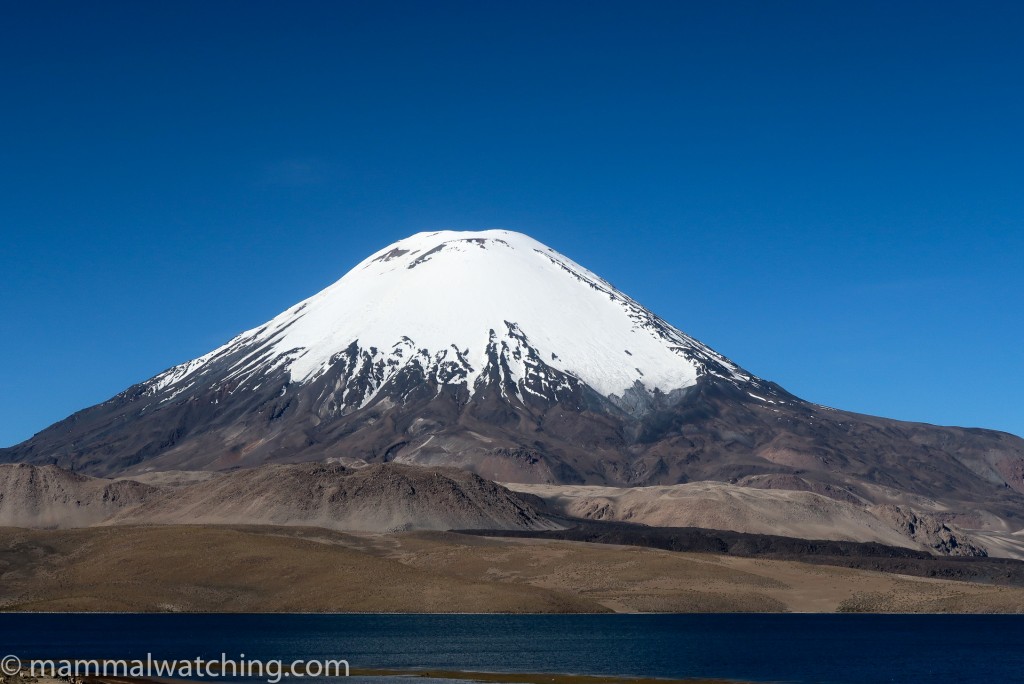
Lake Chungará
We drove to Lake Chungara after visiting Parinacota. Partly to have a look but primarily to try to see the local mice which used to be easy to spot around the picnic tables at the rest area: sit down; open food; summon mice. But a construction crew were busily knocking down the dry-stone wall the mice used to live in to build a shiny new one. No mice for us, though one of the workers said they are still sometimes seen. Hopefully they will return when the work finishes.
Misitune
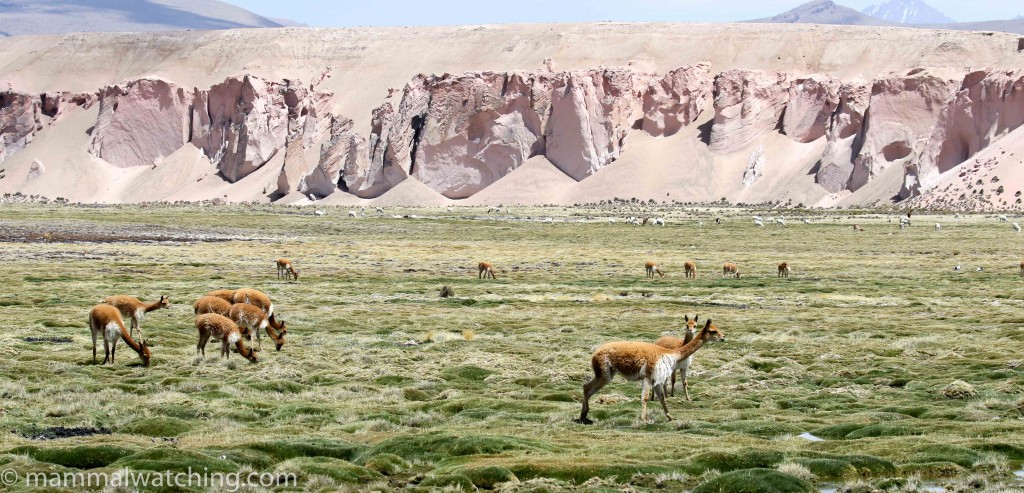
We spent most of our time close to the abandoned settlement of Misitune. Enrique had seen two Mountain Cats close to here in October and we spent many hours scanning good habitat along the Lauca River Valley. The cats were still around: a farmer we met had seen a Mountain Cat here the day before we arrived. However, a crew had been working on the road since Enrique was last here which may have disturbed the animals.
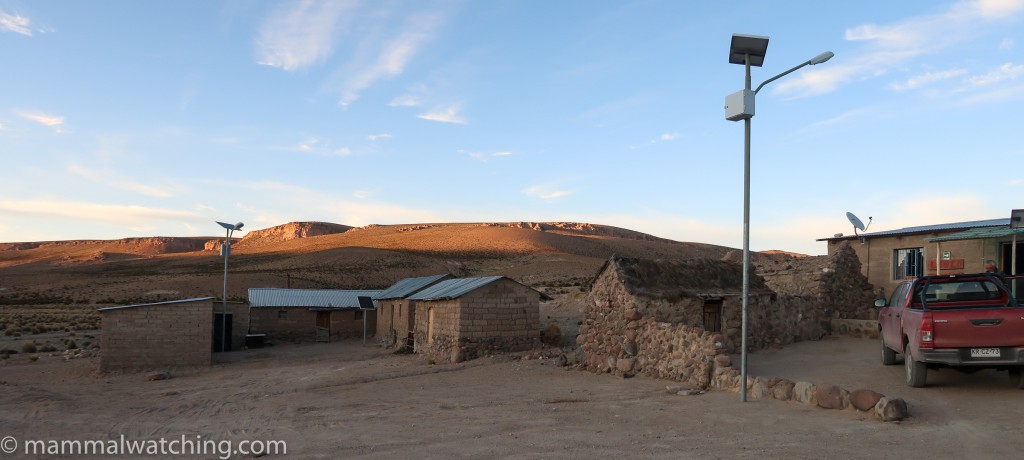
Lauca Cruzani
We stayed in an isolated farmstay called Lauca Cruzani. It is a simple place, but the food was good (most nights at least) and it was warm and clean. The lady running it – Julia Alcon – couldn’t have been friendlier. She doesn’t speak a word of English but smiles a lot. Viscachas were common around here and Vicunas were abundant. We spotted a couple of Culpeos around here as well as a lone Feral Donkey, which have been living wild around here for 400 years or more.
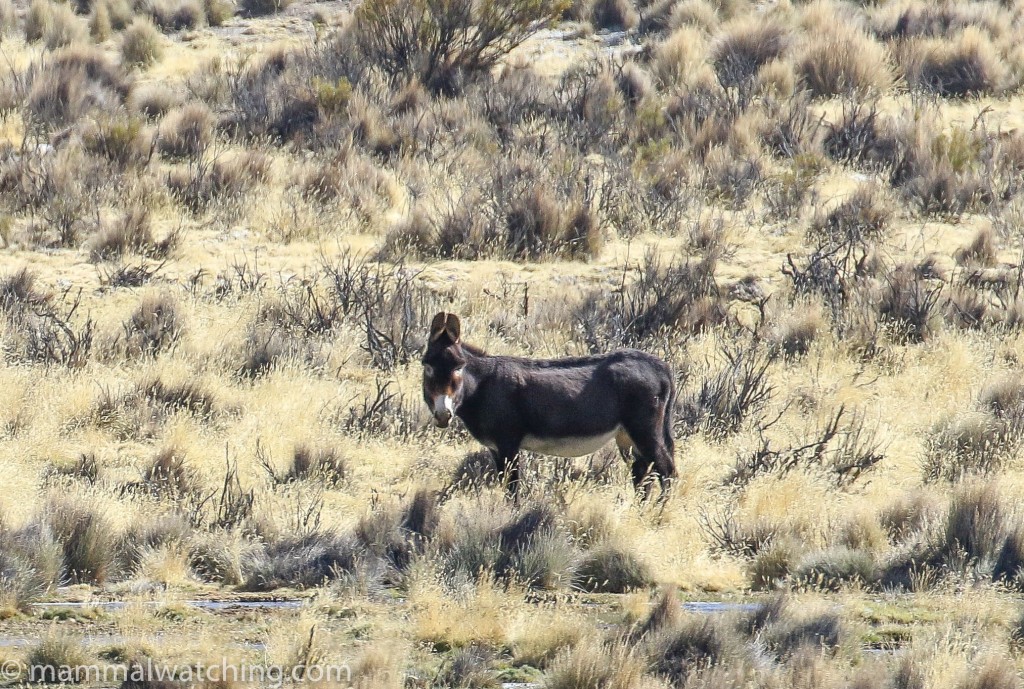
Feral Donkey, Equus asinus
We spent time near a large tuco-tuco colony, animals Enrique thinks are likely predated by Mountain Cats. The best way to see one is to scan fresh mounds for flying dirt. We spotted at least two above the ground in this way.
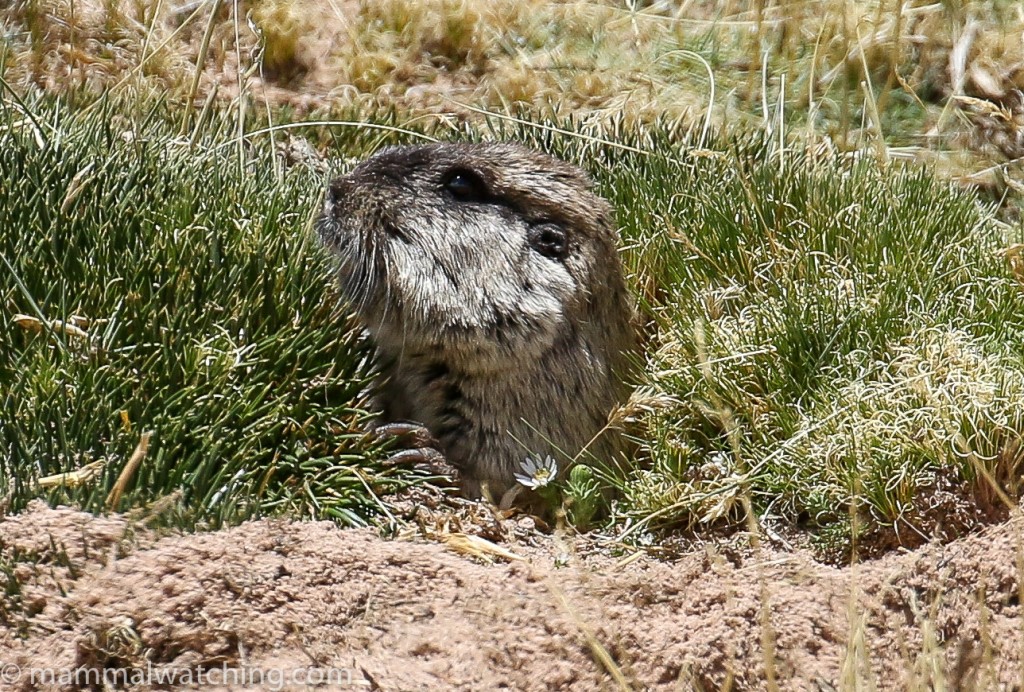
Highland Tuco-tuco, Ctenomys opimus
This species ought to be Highland Tuco-tuco here, and the pictures match some of those in Handbook of the Mammals of the World for example. But, as I said earlier, these animals near Misitune look rather different to those near Parinacota, though perhaps it is just a variable species.
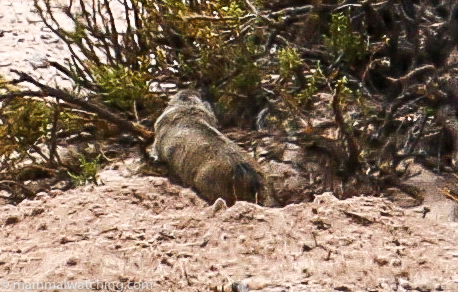
Highland Tuco-tuco, Ctenomys opimus
We caught a couple of species of rodents in small mammal traps set overnight close to the farm. There are 22 rodent species in the park so our IDs were a little tentative at first. But after showing the pictures to some experts I am sure the smaller species were White-bellied Grass Mice (Akodon albiventer).
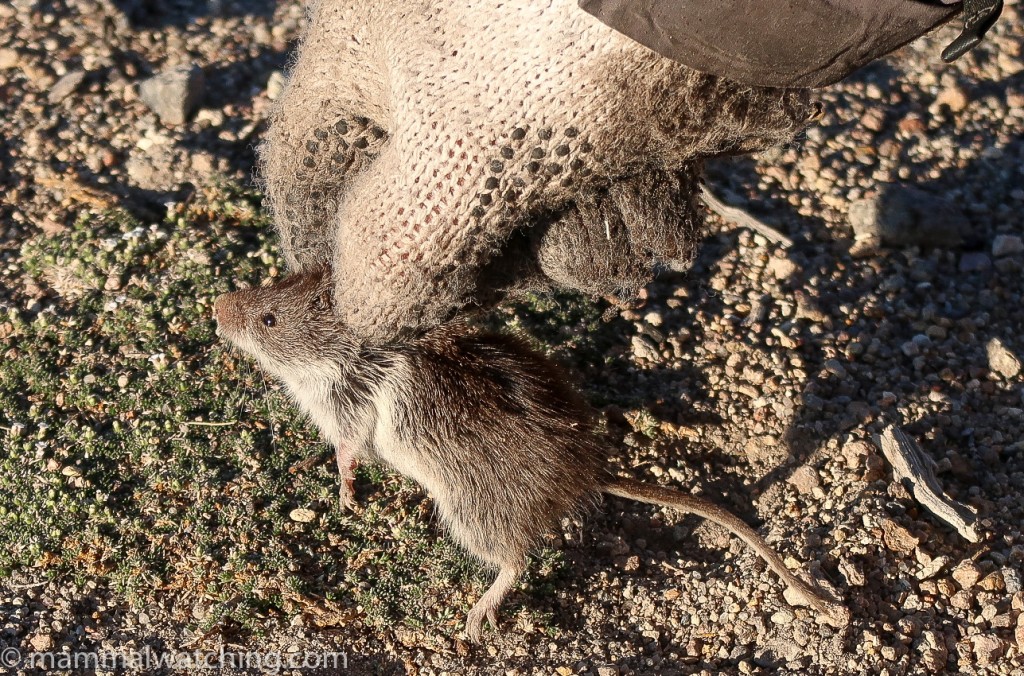
White-bellied Grass Mouse, Akodon albiventer
The larger species, with a small tuft at the end of the tail, was one of the leaf-eared mice (Phyllotis) species. On the basis of size, colouration and how common the different species are, Yellow-rumped Leaf-eared Mouse seems the most likely candidate.
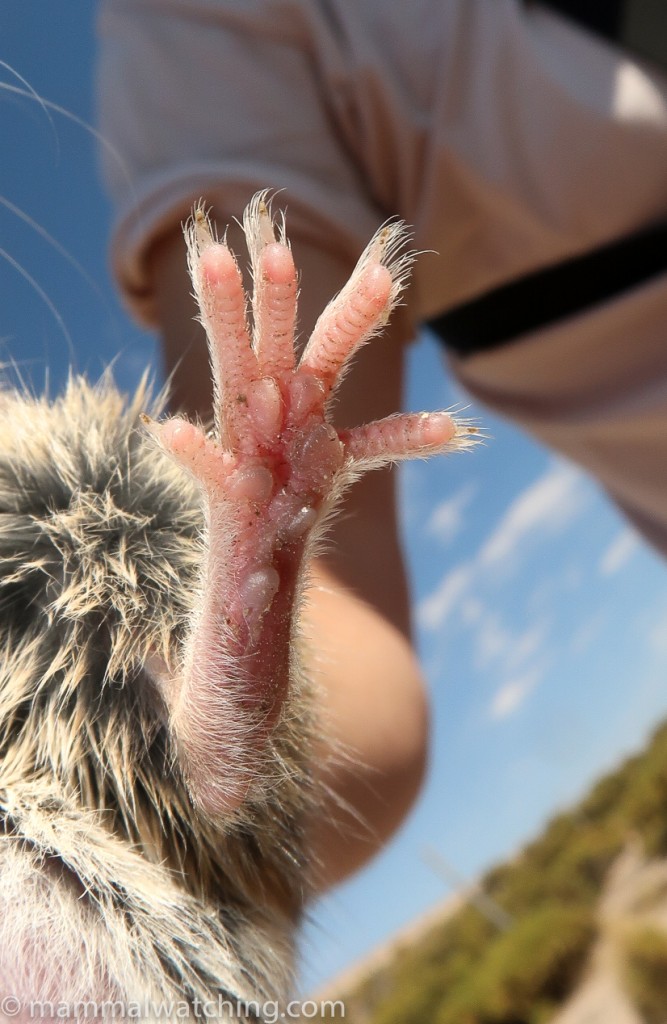
Yellow-rumped Leaf-eared Mouse, Phyllotis xanthopygus feet. At first we thought this animal was one of the Eligmodontia genus, but the feet are not hairy enough.
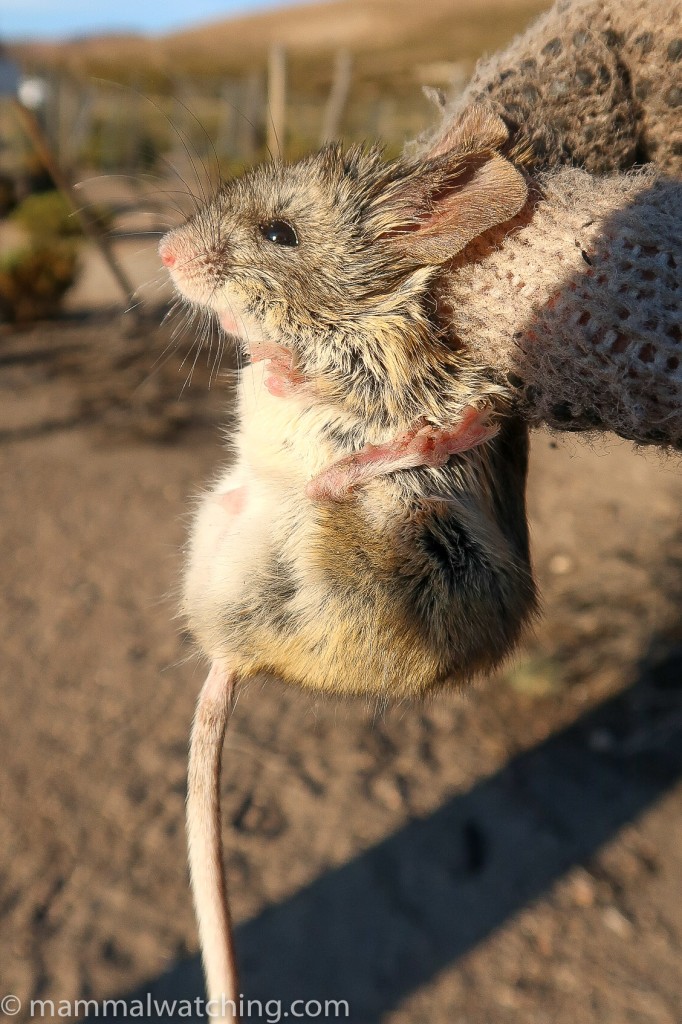
Yellow-rumped Leaf-eared Mouse, Phyllotis xanthopygus
But of course the main target up here were the cats. By Tuesday night we had spent most of the daylight hours for three days looking for cats and seen none. Moreover, a long – and very cold – spotlighting drive on Monday night had also been unproductive. So our spirits, while not quite sinking, were starting to wobble. But on Tuesday, during our second night spotlighting, we picked up bright eyeshine at about 10 p.m close to the farmstay. This just had to be a cat. But which one …?
After a frustrating 15 minutes watching the animal’s eyeshine duck and weave among the bushes 200 metres away, Phil, John and I approached on foot while Enrique kept track of the eyeshine from the car, using his laser pointer to direct us when the cat moved. We got to within 100 metres of it: just close enough to see the animal through my binoculars and illuminated in the beam of my flashlight. I had no doubt it was an Andean Mountain Cat: the very long barred tail was diagnostic. John and Phil also saw the animal and its tail well and were equally confident it was a Mountain Cat.
The cat disappeared over a ridge and we returned to the car and drove on. Fifteen minutes later we spotted more eyeshine. Almost certainly the same animal, a few hundred metres further down the road and higher up the hill side. I couldn’t get onto this one with my binoculars, but John and Phil saw it quite well and were sure it was a cat though neither saw the tail this time.
Some of the pressure was off and our spirits were soaring again. But of course we all wanted a better look.
The next morning we found very fresh track prints on the hillside but despite a couple of hours scanning didn’t see any felines. Nor did we find a cat in the late afternoon. Or during an hour’s spotlighting drive in the same area that evening. So Phil and John hatched a plan for some pre-dawn spotlighting in the hope we could find some eyeshine and wait for daylight.
On Thursday morning, at 6 a.m, Phil picked up eyeshine from exactly the same spot at which we had seen the cat on Tuesday night. The animal didn’t move over the next ten minutes, at which point the first rays of sun were breaking the horizon and it was becoming too bright to see the eyeshine. Right about now Phil picked up a second set of eyeshine, 100-150 metres to the right of the first animal and lower down the slope, again in the shrubbery. But he saw that eyshine only briefly.
The next 15 minutes, stuck in the excruciating limbo of a hillside to bright to be spotlit and too dark to see properly, were tense to say the least. They were also cold. Seriously bloody cold. And we held our breath partly from the agony of the wait, and partly from the pain of the freezing air in our lungs.
By 6.30 am there was enough light to see the hillside. Phil spotted an iota of movement. An iota which turned into a very low slung, long-tailed cat sneaking through some bushes exactly where we had seen the first set of eyeshine. Neither Phil nor I have a shadow of doubt that this was an Andean Mountain Cat: the animal was grey, the tail was long – Snow Leopard long – and well banded. It was also moving in super stealth mode: its legs bent forward at 45 degrees: if cats ever join the Special Forces and need to advance under sniper fire then this is how they would do it. Fabulous stuff: we were very lucky to have seen it for even a second or two. If my binoculars hadn’t been pointing directly at it I would never have spotted it.
There was nothing for another 15 minutes until Phil – yet again Phil! – spotted more movement. I got a briefer glimpse of what we think was the same cat moving back in the direction it had come from.
Twenty minutes later the entire hill side was in bright sunlight and I was beginning to think I would never feel my toes again when someone (I think it might have been me but I am going to say Phil because Phil always sees cats before anyone) saw a cat sitting out in the open, 100 metres or so to the right of where we had last seen our Andean Mountain Cat and close to where we had had the second set of eyeshine.
My first reaction was “that animal looks a lot more yellow”. My second reaction was “there cannot be two cats… it must be a trick of the changing light”. And so I started taking pictures for a good 20 seconds as the cat climbed up the hill side in perfect sunshine. My pictures – below – are uniformly rubbish, with the ISO set super – and unnecessarily – high. While I was taking pictures, John and Phil were watching the animal through their binoculars.
We discussed the morning’s sightings. Although the views of the last animal were excellent it didn’t even cross my mind that this was not a Mountain Cat. The consensus was, that morning at least, that we had likely seen two animals. This was based on the second set of eyeshine and how yellow the second animal (in the photos) was compared to the grey cat we’d seen just after sunrise. Enrique thought the second cat might have been a juvenile.
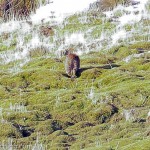
Pampas cat, Leopardus garleppi
So I put up the pictures on Facebook. And several people – who know much more about this that I do – thought the animal was a Pampas Cat. After considerable discussion and photoshopping the pics, that does indeed seem to be the case. The two species can be difficult to tell apart (and not just by me): but some features are key. Andean Cats are greyer and longer tailed than Pampas Cats. The Andean Cat’s tail is more heavily barred and the spots on the body are arranged in vertical lines, rather than the horizontal of the Andean Cat. If you can get close enough then the Andean Cat has a black nose pad, the Pampas Cat a paler one. See this diagram from the Seeking the Andean Cat project.
The markings on both the body and the tail are classic Pampas Cat.
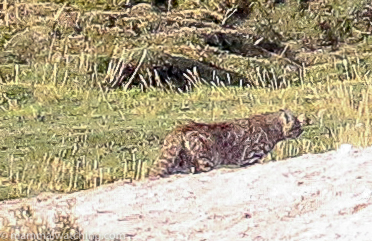
Pampas cat, Leopardus garleppi
Unfortunately the angle of the sighting meant none of us got a good impression for the length of this creature’s tail. It is noticeably thick but then so is the tail of the Colocolo subspecies of Pampas Cat.
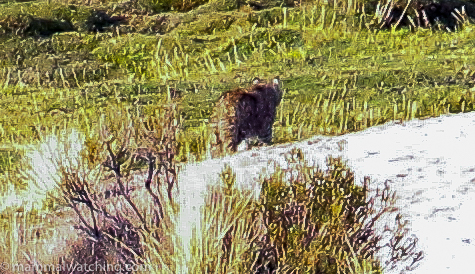
Pampas cat, Leopardus colocolo
I will fully confess that if I was reading about someone else reporting a Pampas Cat and an Andean Mountain Cat within 50 metres and 20 minutes of each other I would be sceptical. But I remain certain that we saw a Mountain Cat that morning. And the pictures speak for themselves about the Pampas Cat. Very glad I took them: without them I would never have added Pampas Cat to my list.
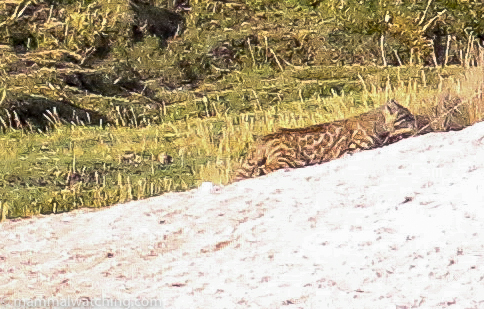
Pampas cat, Leopardus garleppi
Richard Webb was one of those who studied the pictures and feels sure they are a Pampas Cat. He also, reassuringly, felt that seeing the cats side by side was “not as unlikely as it might seem. The two species do occur alongside each other as shown by camera trapping in Bolivia. Other small cats occur sympatrically including Pallas’s & Chinese Desert Cat denning within 150 metres of each other in a small quarry in Sichuan & Ocelot, Margay & Southern Oncilla occurring alongside each other in the Pantanal and elsewhere. ”
Our experiences over five days on the altiplano, and from talking to Enrique, suggest that cats are not all that uncommon up there, but – given their stealth, camouflage and the sheer quantity of available cover – they are extremely difficult to spot by chance. Our technique of finding an area being used by the creatures at night, and returning just before dawn to lock onto one and wait for the sunshine seems an effective way to go. It is worth pointing out that this is the same strategy used by vampire hunters in a great many low budget horror movies from the 1960s and 70s.
Putre to Arica
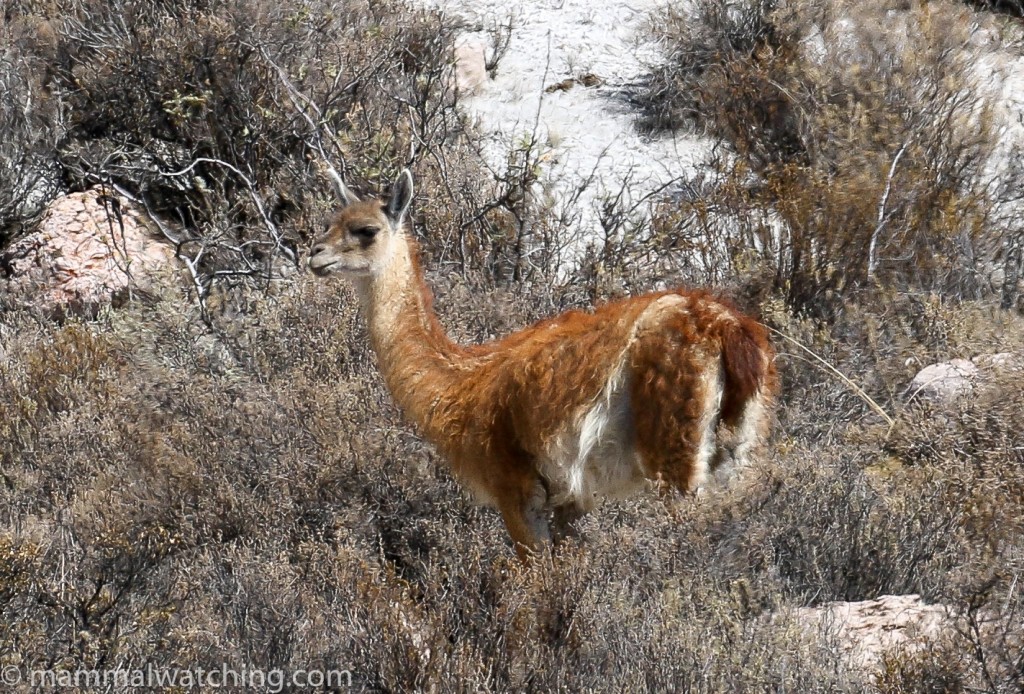
Guanaco, Lama guanicoe
The drive from Putre to Arica is quite scenic but largely mammal-less, unless you are interested in reckless Bolivian lorry drivers. This is the only area around here in which you are likely to see a Guanaco though: keep your eyes open when you reach the cactus belt about an hour down the road from Putre. Enrique spotted a single animal here.
Arica
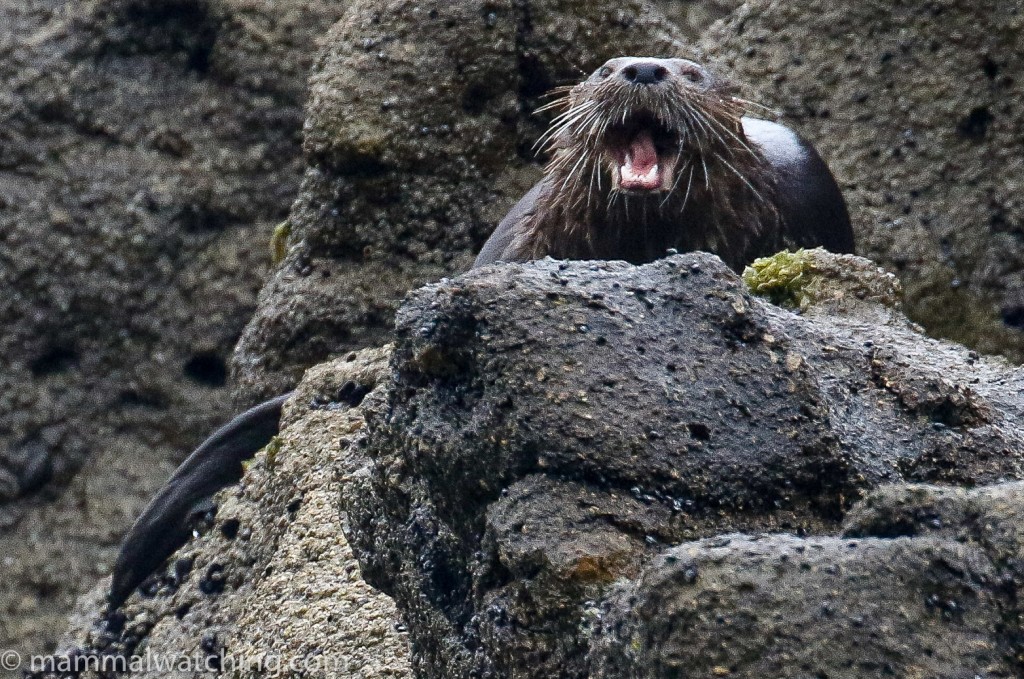
Marine Otter, Lontra felina
Just before I left for Chile I was happily surprised to learn that the mammal watching around Arica was pretty interesting (thanks Ben Schwienhart!). In particular Burmeister’s (Black) Porpoise and Marine Otters are regularly spotted close to the small coastal city. Enrique knew exactly where to look.
We had a day or so around town and early in the morning set out in search of the porpoises. They can often be seen from the long beach – Playa Chinchorro – that runs north of town. Porpoises can be anywhere along the coast here, sometimes just off of the beach. The area near the mouth of the Rio Luta is one place where Enrique has seen them quite close in on several occasions. Calm conditions are vital though if you are to have a chance of seeing them as they move gently through the water. We saw several animals that morning through binoculars and a scope. They were quite a long way off shore and often hard to distinguish from Sealions which are also common off of the beach. The species now has a spot on my “Want better views” list.
Marine Otters seem common around Playa Corazon, about 20 minutes south of town. We parked the car here (at the end of the road before the gate into Cuevas de Anzoata nature reserve). And about 10 seconds later saw a Marine Otter swimming just off the rocks.
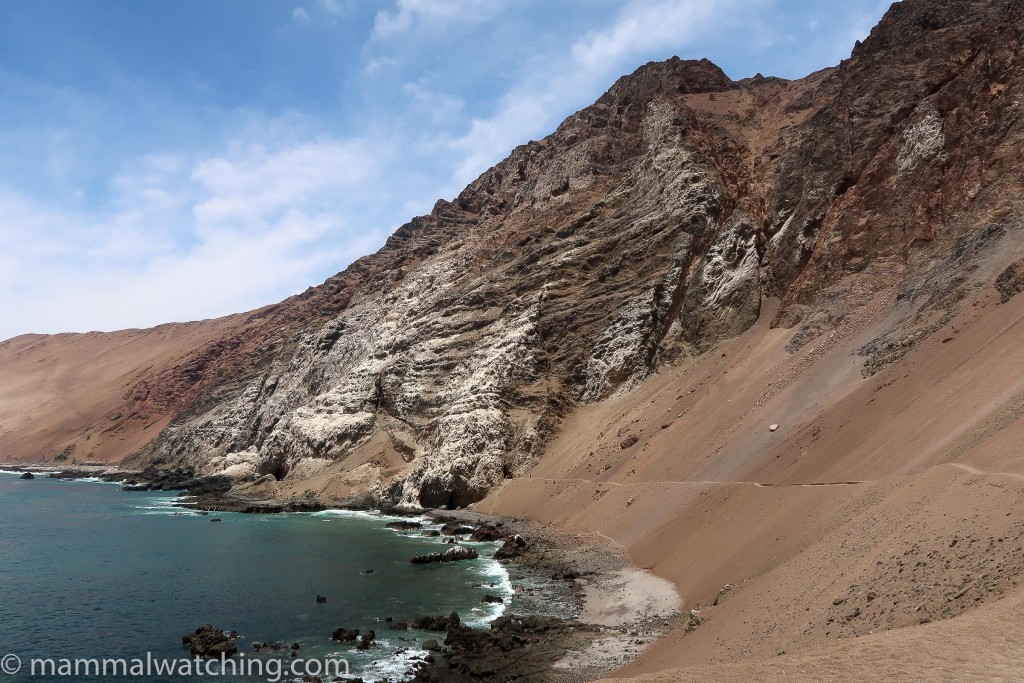
Marine Otter habitat
We saw a least one, possibly two, more animals and one gave wonderful views as it came up onto the rocks to feed. This is a species I have seen only once before, on Chiloe Island.
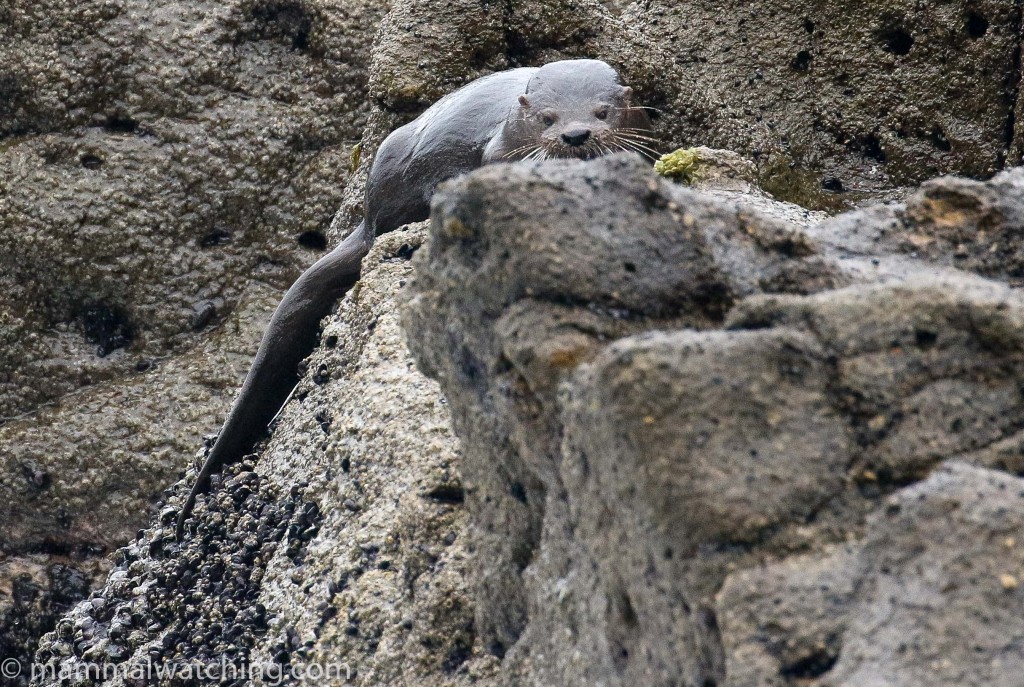
Marine Otter, Lontra felina
Happy with our otter watching we went into the Cuevas de Anzota Reserve. The reserve is locked at night, and opens about 0900 each morning. Entrance is free though you have to register and borrow a hot, heavy and thoroughly unhygenic plastic caving hat.
The reserve is built around a coastal trail that runs along the cliffs through a handful of caves. Information signs said that the only bats in the caves are Common Vampire Bats and I found a few when I returned with a flashlight the following morning (after Phil, John and Enrique had flown to Chiloe Island).
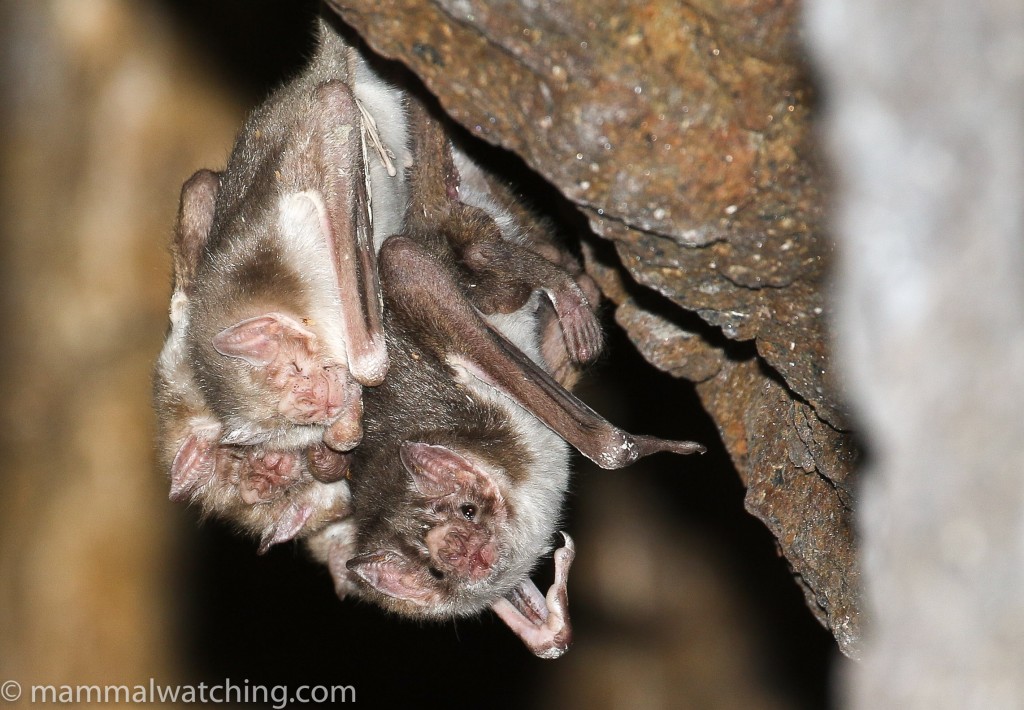
Common Vampire Bat, Desmodus rotundus
I couldn’t find bats in any of the main caves along the trail. But I found a colony in the cave pictured below: it is about 10 minutes walk from the entrance and just after the first of the “official” caves. Getting into it required a small scramble up the scree and then some negotiation with a hissing Turkey Vulture chick. There were plenty of footprints up there but I would be inclined not to climb up there if one of the rangers is around.
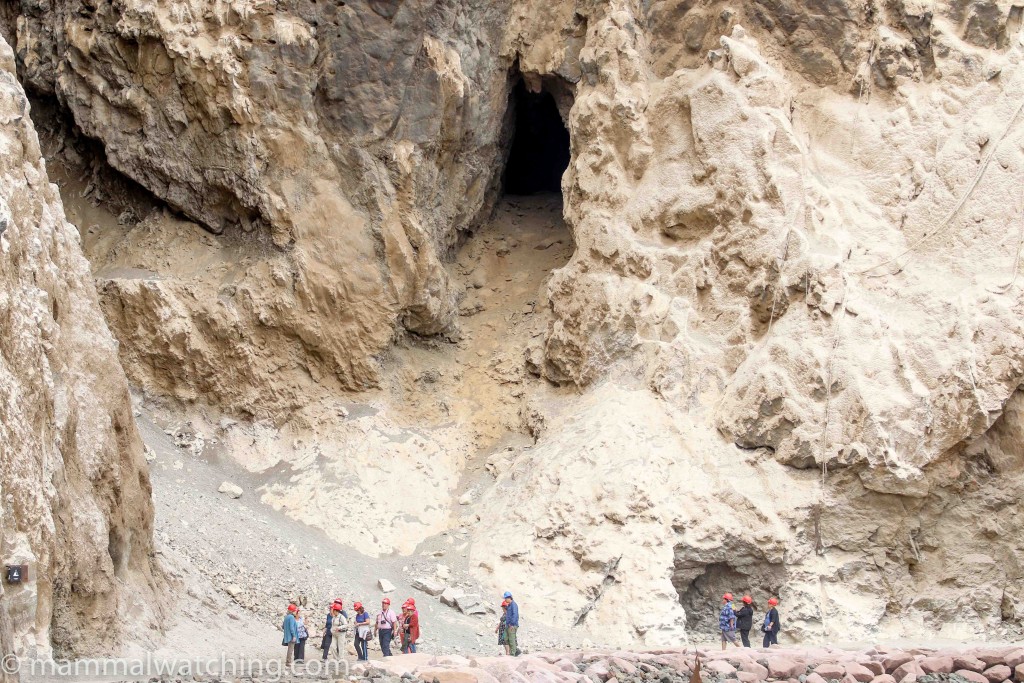
Vampire Bat cave
If you walk along the cliffs for another twenty minutes you will see (and smell) a South American Sealion colony off shore. Try as I might I couldn’t change any of them into fur seals which are very occasionally seen here.
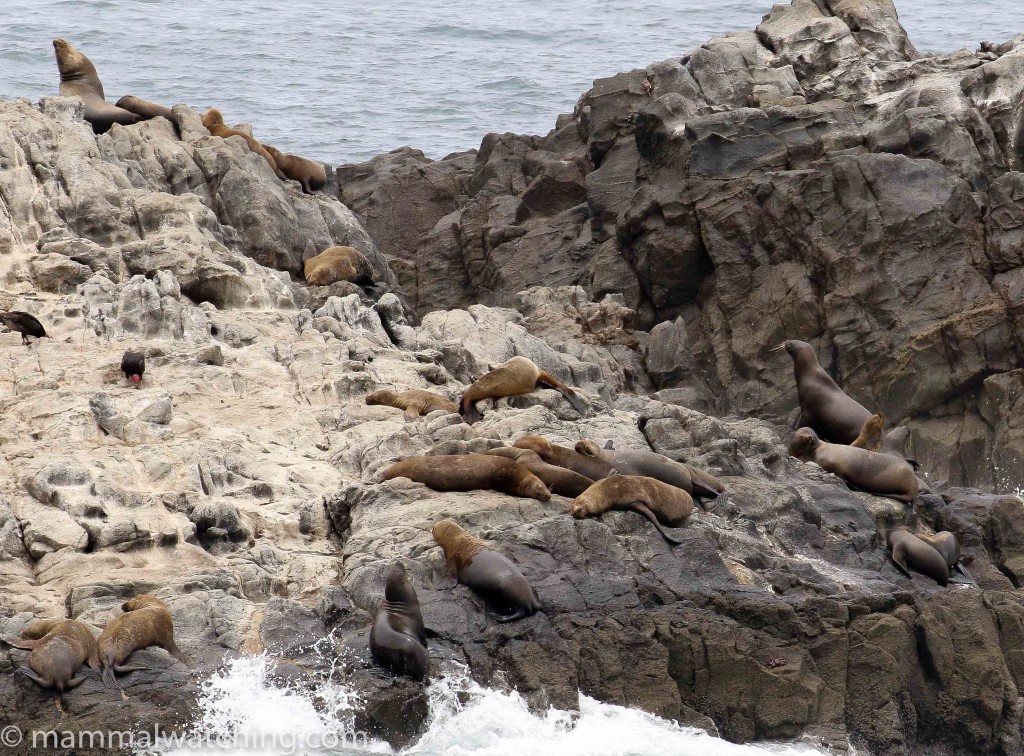
South American Sea Lion, Otaria byronia
On the walk back we spotted one or more whales a kilometre or more off shore. Too large, with too high a blow, to be a Minke but with prominent falcate dorsal fins, these must have been either Bryde’s or Sei Whales. I am not sure we will ever know which.
We set a few small mammal traps in some very thick vegetation on the floodplains of the Rio Lauta estuary. Our captures were all Olive Grass Mice. I drove around the area at night with a bat detector but didn’t record anything.
From Arica John, Phil and Enrique left for Chiloe Island, and I began to catch up on my sleep before returning to New York the next day.
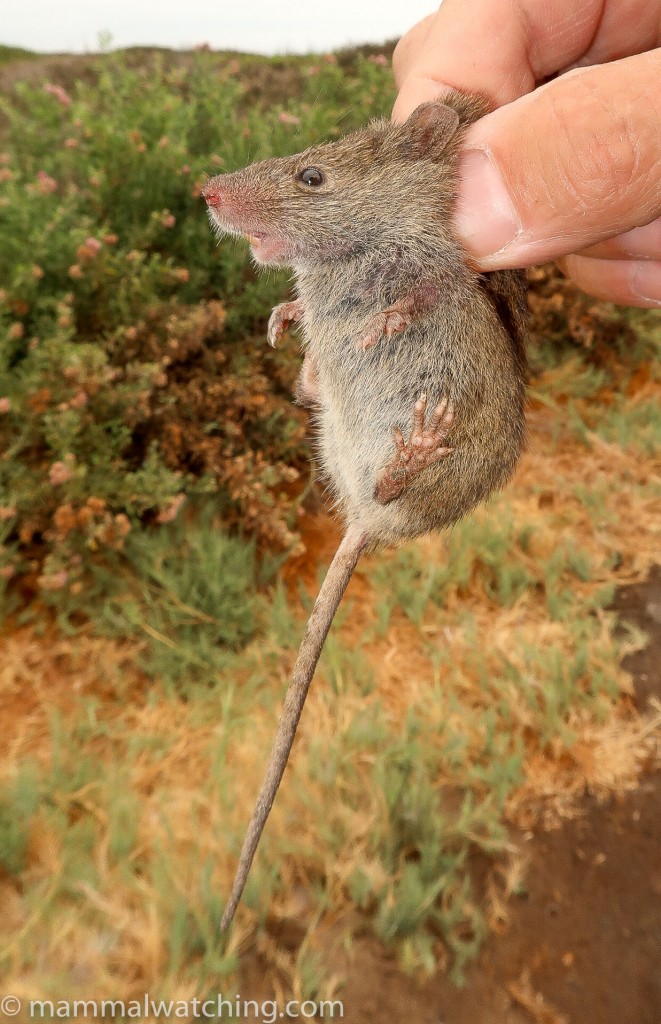
Olive Grass Mouse, Abrothrix olivaceus
Stuff We Missed
This was more of a cat quest than a general mammal trip, and I don’t doubt that with more time for small mammal trapping in particular we would have caught several more species. Some 22 rodent species live in the park and species from genuses like Eligmodontia and Auliscomys ought to be quite common. Indeed we were unlucky not to have seen one more of the larger mice species that are often seen running around the park: these are likely one or more of the Big-eared (Auliscomys) or Leaf-eared (Phyllotis) genuses. Whether or not we saw two species of tuco-tuco remains to be seen.
Among the larger mammals then there was a chance of running into a Puma and we saw fresh tracks. I had hoped to see both Molina’s (Andean) Hog-nosed Skunk (Conepatus chinga) and Andean Hairy Armadillos (Chaetophractus nationi). Although both species were at one time qute common in the area, Enrique said it had been several years since he had seen either near the park.
Thank You
A massive thanks from John, Phil and me to Enrique Couve and his team at Far South Expeditions. A great guy to spend time in the field with, and to share a bottle of wine with. Chilean wine of course. Enriqiue has perpetual energy so catch up on sleep before you travel with him! He absolutely couldn’t have tried harder to find us the cats and every other mammal we mentioned.
Thank you also to Bruce Patterson, Pablo Teta and Doug Kelt for advice on our small mammal captures (though any misakes in my IDs are my fault, not their’s), and to Ben Schwienhart and Adam Walleyn for the information on mammals around Arica and for all those who weighed in on the Andean-then-Pampas Cat pictures, particularly Richard Webb, Jeff Blincow and Rodrigo Villalobos from Seeking the Andean Cat. And thanks to Phil and John for being great trip companions, and to Phil for taking the lead in organising the trip.
Trip List
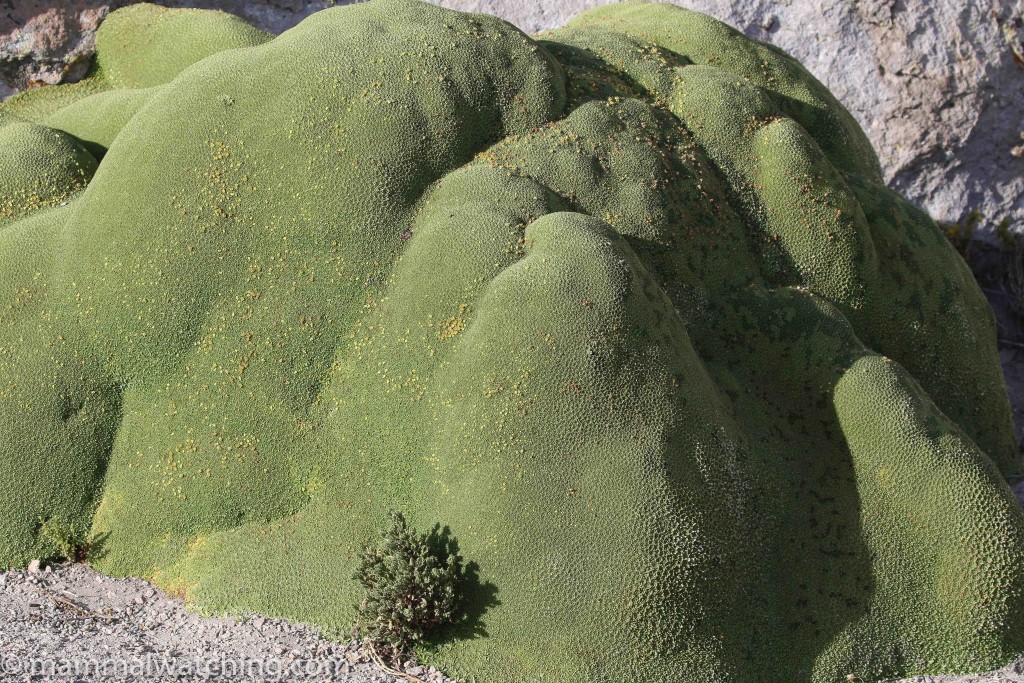
Llareta plant
- White-bellied Grass Mouse Akodon albiventer
- Olive Grass Mouse Abrothrix olivaceus
- Andean Grass Mouse Abrothrix andinus
- Yellow-rumped Leaf-eared Mouse Phyllotis xanthopygus
- Highland Tuco-tuco Ctenomys opimus
- Southern Mountain Viscacha Lagidium viscacia
- Garlepp’s Pampas Cat Felis garleppi
- Andean Cat Felis jacobita
- Culpeo Lycalopex culpaeus
- South American Sea-Lion Otaria byronia
- Marine Otter Lontra felina
- Common Vampire Bat Desmodus rotundus
- Sei/Bryde’s Whale Balaenoptera brydei/borealis
- Burmeister’s Porpoise Phocoena spinipinnis
- Guanaco Lama guanicoe
- Vicuna Vicugna vicugna
- Taruca (Northern Huemal) Hippocamelus antisensis
- Feral Donkey Equus asinus
10 Lifers in bold.
Chiloe Island Post Trip Excursion (John Wright)
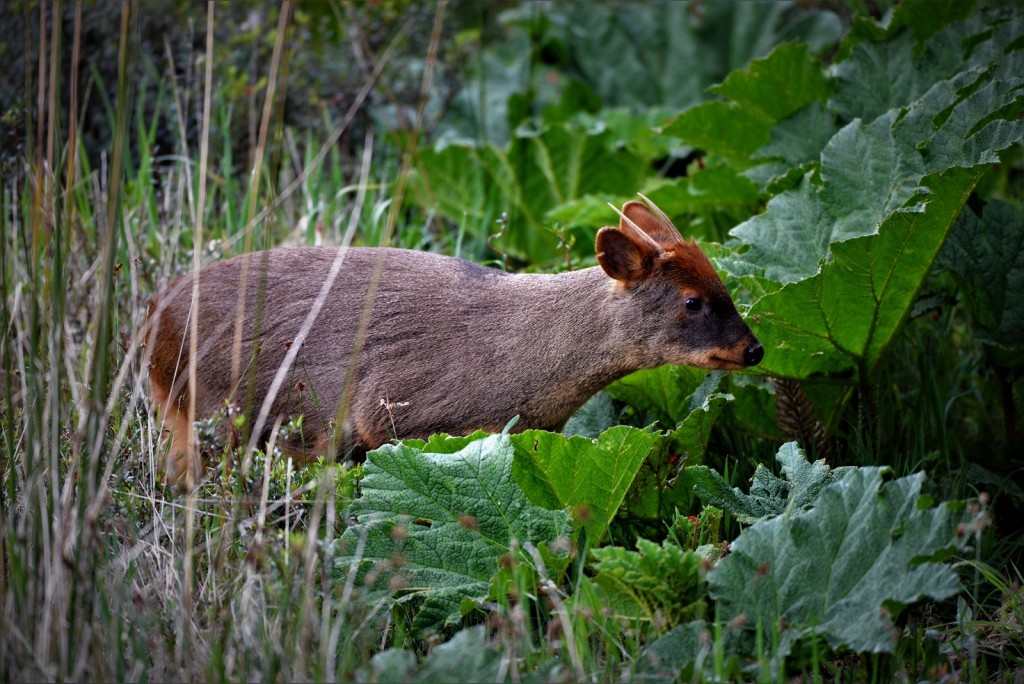
Southern Pudu, Pudu puda. Photo Phil Telfer
On Saturday 24th myself, Phil and Enrique said our farewells to Jon at Arica airport in time for our 20:10 flight to Santiago. We spent the night in a hotel near the airport in Santiago.
The following day we flew to Chiloe Island where we spent 3 nights at Tepuhueico. The targets here were Kodkod, Darwin’s Fox and Pudu – all 3 species Phil and Enrique had seen here before. To cut a long story short we found plenty of Pudus, at least 5 sightings a day, but not the cat or the fox despite putting in many hours walking the trails day and night and at a stakeout. We flew back to Santiago in the afternoon of the 28th where we said our goodbyes to Enrique. Phil and I stayed overnight before our flight back to the UK the following day.
Note: The accommodation and food at Tepuhueico were fine but a little overpriced in our opinion, the staff were helpful, cheerful and friendly. The main problem is the river bridge that takes you onto the Tepuheico complex/reserve was destroyed by a flood about 2 years ago and there doesn’t seem to be any moves to get it fixed any time soon. It’s apparently going to cost a lot to replace and probably comes down to who should pay for it! We had to get a boat to/from the lodge and accommodation across Lake Tepuhueico.
11 Comments
-
-
-
Vladimir Dinets
The plant is called llareta: https://en.wikipedia.org/wiki/Yareta
I’ve seen such white-bellied vamps on Peru coast many years ago; I still think they look too distinctive to be just common vampires; something to look into.
-
-
Sebastian Kennerknecht
What a fantastic trip. As you have concluded I am one hundred percent confident that is a pampas cat.
Leave a Reply
You must be logged in to post a comment.


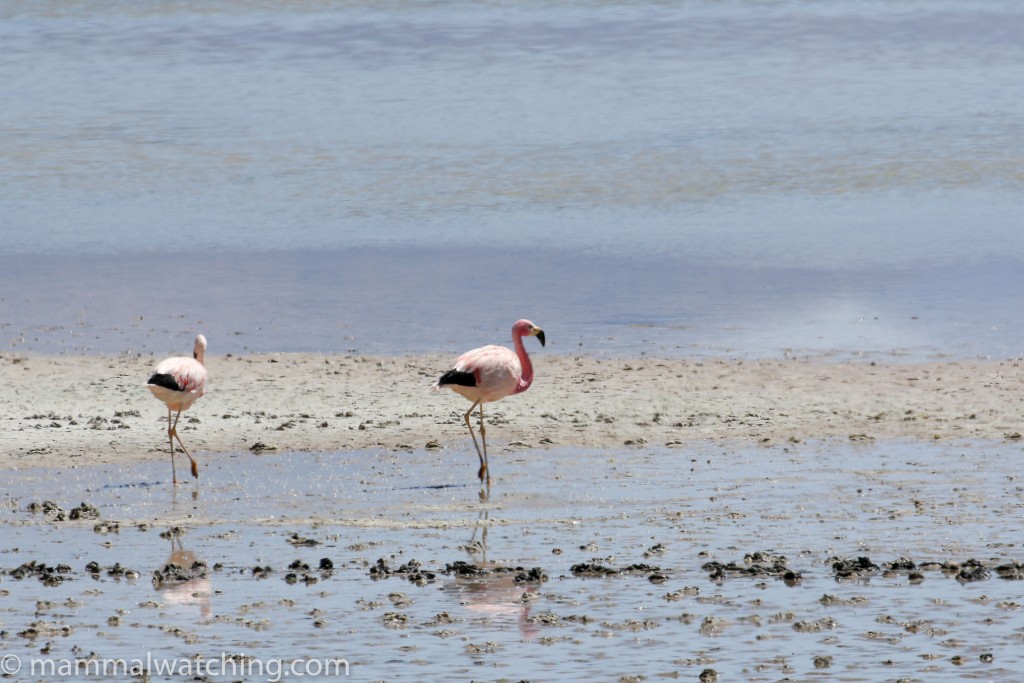
william boehm
well written and quite an amazing journey. i have explored lake Sabinacocha in peru in the past (1980), an untouched altiplano lake, but never saw any of cats, however but lots of vicuna, huemel deer and vizcacha colonies. i have wanted to return . thankyou for sharing